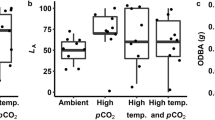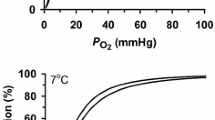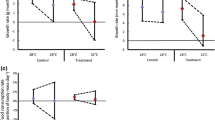Abstract
In fish, regional endothermy (i.e., the capacity to significantly elevate tissue temperatures above ambient via vascular heat exchangers) in the red swimming muscles (RM) has evolved only in a few marine groups (e.g., sharks: Lamnidae, Alopiidae, and teleosts Scombridae). Within these taxa, several species have also been shown to share similar physiological adaptations to enhance oxygen delivery to the working tissues. Although the hemoglobin (Hb) of most fish has a decreased affinity for oxygen with an increase in temperature, some regionally endothermic teleosts (e.g., tunas) have evolved Hbs that have a very low or even an increased affinity for oxygen with an increase in temperature. For sharks, however, blood oxygen affinities remain largely unknown. We examined the effects of temperature on the blood oxygen affinity in two pelagic species (the regionally endothermic shortfin mako shark and the ectothermic blue shark) at 15, 20, and 25 °C, and two coastal ectothermic species (the leopard shark and brown smooth-hound shark) at 10, 15, and 20 °C. Relative to the effects of temperature on the blood oxygen affinity of ectothermic sharks (e.g., blue shark), shortfin mako shark blood was less affected by an increase in temperature, a scenario similar to that documented in some of the tunas. In the shortfin mako shark, this may act to prevent premature oxygen dissociation from Hb as the blood is warmed during its passage through vascular heat exchangers. Even though the shortfin mako shark and blue shark occupy a similar niche, the effects of temperature on blood oxygen affinity in the latter more closely resembled that of the blood in the two coastal shark species examined in this study. The only exception was a small, reverse temperature effect (an increase in blood oxygen affinity with temperature) observed during the warming of the leopard shark blood under simulated arterial conditions, a finding that is likely related to the estuarine ecology of this species. Taken together, we found species-specific differences in how temperature affects blood oxygen affinity in sharks, with some similarities between the regionally endothermic sharks and several regionally endothermic teleost fishes.





Similar content being viewed by others

Explore related subjects
Discover the latest articles and news from researchers in related subjects, suggested using machine learning.References
Ackerman JT, Kondratieff MC, Matern SA, Cech JJ (2000) Tidal influence on spatial dynamics of leopard sharks, Triakis semifasciata, in Tomales Bay, California. Environ Biol Fish 58:33–43
Alexander N, Laurs RM, McIntosh A, Russell SW (1980) Haematological characteristics of albacore Thunnus alalunga (Bonnaterre) and skipjack Katsuwonus pelamis (Linnaeus). J Fish Biol 16:383–395
Andersen ME, Olson JS, Gibson QH (1973) Studies on ligand binding to hemoglobins from teleosts and elasmobranchs. J Biol Chem 10:331–341
Anderson SA, Goldman KJ (2001) Temperature measurements from salmon sharks, Lamna ditropis, in Alaskan waters. Copeia 2001:794–796
Bernal D, Lowe, C (2015) Field studies of elasmobranch physiology. In: Shadwick RE, Farrell AP, Brauner CJ (eds) Fish physiology. Physiology of elasmobranch fishes. Part A. vol 34. Academic Press, pp. 311-377
Bernal D, Dickson KA, Shadwick RE, Graham JB (2001a) Analysis of the evolutionary convergence for high performance swimming in lamnid sharks and tunas. Comp Biochem Physiol A 129:695–726
Bernal D, Sepulveda C, Graham JB (2001b) Water-tunnel studies of heat balance in swimming mako sharks. J Exp Biol 204:4043–4054
Bernal D, Smith D, Lopez G, Weitz D, Grimminger T, Dickson K, Graham JB (2003) Comparative studies of high performance swimming in sharks. II. Metabolic biochemistry of locomotor and myocardial muscle in endothermic and ectothermic sharks. J Exp Biol 206:2845–2857
Bernal D, Donley JM, Shadwick RE, Syme DA (2005) Mammal-like muscles power swimming in a cold-water shark. Nature 437:1349–1351
Bernal D, Sepulveda C, Musyl M, Brill R (2009) The eco-physiology of swimming and movement patterns of tunas, billfishes, and large pelagic sharks. In: Domenici P, Kapoor D (eds) Fish locomotion—an etho-ecological approach. Enfield Scientific Publishers, Enfield, NH, p 436–483
Bernal D, Brill RM, Dickson KA, Shiels HA (2017) Sharing the water column: physiological mechanisms underlying species-specific habitat use in tunas. Rev Fish Biol Fish 27:843–880
Boutilier RG, Heming TA, Iwama GK (1984) Appendix: physiochemical parameters for use in fish respiratory physiology. In: Hoar WS, Randall DJ (eds) Fish physiology. Gills. Part A: anatomy, gas transfer, and acid base regulation, vol. 10. Academic Press, New York, pp 403–430
Brill RW (1996) Selective advantages conferred by the high performance physiology of tunas, billfishes, and dolphin fish. Comp Biochem Physiol A 113:3–15
Brill RW, Bushnell PG (1991) Effects of open- and closed-system temperature changes on blood dissociation curves of skipjack tuna, Katsuwonus pelamis, and yellowfin tuna, Thunnus albacares. Can J Zool 69:1814–1821
Brill RW, Bushnell PG (2006) Effects of open- and closed-system temperature changes on blood-O2 binding characteristics of Atlantic bluefin tuna (Thunnus thynnus). Fish Physiol Biochem 32:283–294
Brill RW, Block BA, Boggs CH, Bigelow KA, Freund EV, Marcinek DJ (1999) Horizontal movements and depth distribution of large adult yellowfin tuna (Thunnus albacares) near the Hawaiian islands, recoded using ultrasonic telemetry: implications for the physiological ecology of pelagic fishes. Mar Biol 133:395–408
Brill R, Bushnell P, Schroff S, Seifert R, Galvin M (2008) Effects of anaerobic exercise accompanying catch and release fishing on blood oxygen affinity of the sandbar shark (Carcharhinus plumbeus Nardo). J Exp Mar Biol Ecol 354:132–143
Butler PJ, Metcalfe JD (1988) Cardiovascular and respiratory systems. In Shuttlewroth TJ (ed) Physiology of elasmobranch fishes. Springer, Berlin, Heidelberg. pp. 1-47.
Campos BR, Fish MA, Jones G, Riley RW, Allen PJ, Klimley AP, Cech JJ, Kelly JT (2009) Movements of brown smooth-hounds in Tomales Bay, California. Environ Biol Fish 85:3–13
Carey FG, Gibson QH (1977) Reverse temperature dependence of tuna hemoglobin oxygenation. Biochem Biophys Res Commun 78:1376–1382
Carey FG, Scharold JV (1990) Movements of blue sharks, Prionace glauca, in depth and course. Mar Biol 106:329–342
Carey FG, Teal JM (1969) Mako and porbeagle: warm bodied sharks. Comp Biochem Physiol A 28:199–204
Carey FG, Teal JM, Kanwisher JW, Lawson KD, Beckett JS (1971) Warm-bodied fish. Am Zool 11:135–143
Carey FG, Teal JM, Kanwisher JW (1981) The visceral temperatures of mackerel sharks (Lamnidae). Physiol Zool 54:334–344
Carey FG, Casey JG, Pratt HL, Urquhart D, McCosker JE (1985) Temperature, heat production and heat exchange in lamnid sharks. Mem So Calif Acad Sci 9:92–108
Cech JJ, Laurs RM, Graham JB (1984) Temperature-induced changes in blood gas equilibria in the albacore, Thunnus alalunga, a warm-bodied tuna. J Exp Biol 109:92–108
Clauvel M, Schwartz K (1968) Blood oxygen capacity: technical difficulties of its determination by the Van Slyke method and comparison with hemoglobin content. Clin Chem 14:253–261
Cliff G, Thurman GD (1984) Pathological and physiological effects of stress during capture and transport in the juvenile dusky shark, Carcharhinus obscurus. Comp Biochem Physiol 78A:167–173
Cooper AR, Morris S (2004) Hemoglobin function and respiratory status of the Port Jackson shark, Heterodontus portusjacksoni, in response to lowered salinity. J Comp Physiol B 174:223–236
Davenport HW (1974) The ABC of acid-base chemistry. University of Chicago Press, Chicago
Dewar H, Graham JB (1994) Studies of tropical tuna swimming performance in a large swimming tunnel: I. Energetics. J Exp Biol 192:13–31
Dickson KA, Graham JB (2004) Evolution and consequences of endothermy in fishes. Physiol Biochem Zool 77:998–1018
Edwards MJ, Martin RJ (1966) Mixing technique for the oxygen-hemoglobin equilibrium and Bohr effect. J Appl Physiol 21:1898–1902
Emery SH (1985) Hematology and cardiac morphology in the great white shark, Carcharodon carcharias. So Calif Acad Sci Mem 9:73–80
Emery SH (1986) Hematological comparisons of endothermic vs. ectothermic elasmobranch fishes. Copeia 1996:700–705
Graham JB, Dickson KA (2004) Tuna comparative physiology. J Exp Biol 207:4015–4024
Graham JB, Dewar H, Lai NC, Lowell WR, Arce SM (1990) Aspects of shark swimming performance determined using a large water tunnel. J Exp Biol 151:175–192
Haeseker SL, Cech JJ (1993) Food habits of the brown smooth-hound shark (Mustelus henlei) from two sites in Tomales Bay. Calif Fish Game 79:89–95
Hall FG (1960) A tonometric apparatus for constant flow gas equilibrium. J Appl Physiol 15:312–313
Harms T, Ross T, Segars A (2002) Plasma biochemistry reference values for wild bonnethead sharks Sphyrna tiburo. Vet Clin Pathol 31:111–115
Hight BV, Lowe CG (2007) Elevated body temperatures of female leopard sharks, Triakis semifasciata, while aggregating in shallow nearshore embayments: evidence of behavioral thermoregulation? J Exp Mar Biol Ecol 352:114–128
Hoar WS, Hickman CP (1983) A laboratory companion for general and comparative physiology. Prentice Hall, New Jersey, p 340
Holts DB, Bedford DW (1993) Horizontal and vertical movements of the shortfin mako, Isurus oxyrinchus, in the Southern California Bight. Aust J Mar Freshwat Res 44:45–60
Hopkins TE, Cech JJ (1994) Temperature effects of blood-oxygen equilibria in relation to movements of the bat ray, Myliobatis californica, in Tomales Bay, California. Mar Behav Physiol 24:227–235
Hopkins TE, Cech JJ (2003) The influence of environmental variables on the distribution and abundance of elasmobranch fishes in Tomales Bay, California. Environ Biol Fish 66:279–291
Howell BJ, Baumgardner FW, Bondi K, Rahn F (1970) Acid-base balance in cold-blooded vertebrates as a function of body temperature. Am J Phys 218:600–606
Jensen FB (1991) Multiple strategies in oxygen and carbon dioxide transport by haemoglobin. In: Woakes J, Grieshaber MK, Bridges CR (eds) Physiological strategies for gas exchange and metabolism. Cambridge University Press, Cambridge, pp 55–78
Kaufman RC, Houck AG, Cech JJ (2006) Effects of temperature and carbon dioxide on green sturgeon blood-oxygen equilibria. Environ Biol Fish 76:119–127
Lai NC, Graham JB, Burnett L (1990) Blood respiratory properties and the effect of swimming on blood gas transport in the leopard shark Triakis semifasciata. J Exp Biol 151:161–173
Larsen C, Malte H, Weber RE (2003) ATP-induced reverse temperature effect in iso-hemoglobins from the endothermic porbeagle shark, Lamna nasus. J Biol Chem 278:30741–30747
Loefer JK, Sedberry GR, McGovern JC (2005) Vertical movements of a shortfin mako in the western North Atlantic as determined by pop-up satellite tagging. Southeast Nat 4:237–246
Love M (1996) Probably more than you want to know about the fishes of the Pacific coast, 2nd edn. Really Big Press, Santa Barbara 335 p
Lowe TE, Brill RW, Cousins KL (2000) Blood oxygen-binding characteristics of bigeye tuna (Thunnus obesus), a high-energy-demand teleost that is tolerant to low ambient oxygen. Mar Biol 136:1087–1098
Mandelman JW, Skomal GB (2009) Differential sensitivity to capture stress assessed by blood acid-base status in five carcharhinid sharks. J Comp Physiol B 179:367–277
Matern SA, Cech JJ, Hopkins TE (2000) Diel movements of bat rays, Myliobatis californica, in Tomales Bay, California: evidence for behavioral thermoregulation? Environ Biol Fish 58:173–182
Miklos P, Katzman SM, Cech JJ (2003) Effect of temperature on oxygen consumption of the leopard shark, Triakis semifasciata. Environ Biol Fish 66:15–18
Miller DJ, Lea RN (1972) Guide to the coastal marine fishes of California: California Fish Bulletin Number 157. Division of Agricultural Sciences, University of California, Richmond
Morrison PR, Gilmour KM, Brauner CJ (2015). Oxygen and carbon dioxide transport in elasmobranchs. In: Shadwick RE, Farrell AP, Brauner CJ (eds) Fish physiology. Physiology of elasmobranch fishes. Part B. vol 34. Academic Press, pp. 127–219
Mumm DP, Atha DH, Riggs A (1978) The hemoglobin of the common sting-ray, Dasyatis sabina: structural and functional properties. Comp Biochem Physiol B 60:189–193
Nikinmaa M (1990) Oxygen Transport. In: Vertebrate Red Blood Cells. Zoophysiology, vol 28. Springer, Berlin, Heidelberg
Nikinmaa M, Salama A (1998) Oxygen transport in fish. In: Perry SF, Tufts BL (eds) Fish physiology. Fish respiration, vol 17. Academic Press, San Diego, pp 141–184
Powers DA, Martin JP, Garlick RL, Fyhn HJ, Fyhn UEH (1979) The effect of temperature on the oxygen equilibria of fish hemoglobins in relation to environmental thermal variability. Comp Biochem Physiol A 62:87–94
Reeves RB (1976) Temperature-induced changes in blood acid-base status: pH and PCO2 in a binary buffer. J Appl Physiol 40:752–761
Riggs A (1970) Properties of fish hemoglobins. In: Hoar WS, Randall DJ (eds) Fish physiology. the nervous system, circulation, and respiration, vol 4. Academic Press, New York, pp 209–252
Root RW (1931) The respiratory function of the blood of marine fishes. Biol Bull 61:427–456
Rossi-Fanelli A, Antonini E (1960) Oxygen equilibrium of hemoglobin from Thunnus thynnus. Nature 186:895–896
Schaefer KM, Fuller DW, Block BA (2007) Movements, behavior, and habitat utilization of yellowfin tuna (Thunnus albacares) in the northeastern Pacific Ocean, ascertained through archival tag data. Mar Biol 52:503–525
Scheid P, Meyer M (1978) Mixing technique for study of oxygen-hemoglobin equilibrium: a critical evaluation. J Appl Physiol Respir Environ Exerc Physiol 45:818–822
Sepulveda CA, Kohin S, Chan C, Vetter R, Graham JB (2004) Movement patterns, depth preferences, and stomach temperatures of free-swimming juvenile mako sharks, Isurus oxyrinchus, in the Southern California Bight. Mar Biol 145:191–199
Sepulveda CA, Graham JB, Bernal D (2007) Aerobic metabolic rates of swimming juvenile mako sharks, Isurus oxyrinchus. Mar Biol 152:1087–1094
Setka JD, Cech JJ (1994) Blood and muscle characteristics of leopard shark (Triakis semifasciata) and brown smooth-hound (Mustelus henlei). Calif Fish Game 80:89–96
Sharp GD (1975) A comparison of the O2 dissociation properties of some scombrid hemoglobins. Comp Biochem Physiol 51A:683–691
Smith RL, Rhodes D (1983) Body temperature of the salmon shark, Lamna ditropis. J Mar Biol Assoc UK 63:243–244
Smith SV, Hollibaugh JT, Dollar SJ, Vink S (1991) Tomales Bay metabolism: C-N-P stoichiornetry and ecosystem heterotrophy at the land-sea interface. Estuar Coast Shelf Sci 33:223–257
Stevens ED, Randall DJ (1967) Changes of gas concentrations in blood and water during moderate swimming activity in rainbow trout. J Exp Biol 46:329–337
Stevens ED, Kanwisher JW, Carey FG (2000) Muscle temperature in free-swimming giant Atlantic bluefin tuna (Thunnus thynnus L.) J Therm Biol 25:419–423
Tucker V (1967) Method for oxygen content and dissociation curves on microliter blood samples. J Appl Physiol 23:410–414
Webber JD, Cech JJ (1998) Non-destructive diet analysis of the leopard shark, Triakis semifasciata, from two sites in Tomales Bay, California. Calif Fish Game 84:18–24
Weber RE (1983) TMAO (trimethylamine-oxide)-independence of oxygen affinity and its urea and ATP sensitivities in an elasmobranch hemoglobin. J Exp Zool 228:551–554
Wells RMG, Davie PS (1985) Oxygen binding by the blood and hematological effects of capture stress in two big gamefish: mako shark and striped marlin. Comp Biochem Physiol A 81:643–646
Wells RMG, Weber RE (1983) Oxygenational properties and phosphorylated metabolic intermediates in blood and erythrocytes of the dogfish, Squalus acanthus. J Exp Biol 103:95–108
Wood CM, McMahon BR, McDonald DG (1977) An analysis of changes in blood pH following exhausting activity in the starry flounder, Platichthys stellatus. J Exp Biol 69:173–185
Wyman J (1964) Linked functions and reciprocal effects in hemoglobin: a second look. Adv Protein Chem 19:223–286
Acknowledgements
We thank S. Matern for the help with coastal sharks collection; J. Clegg, P. Siri, K. Brown, K. Briggman, and W. Borgeson for the facilities and animal care help at the BML; C. Crocker and H. Boyle for the experimental technique help; R. Kaufman, J. Poletto, and D. Cocherell for the statistical assistance; and P. Cala and J. Payne for the comments on drafts of the manuscript. We thank the three anonymous reviewers for their thoughtful comments and suggestions, which significantly improved the quality of this manuscript.
Funding
We are indebted to T. Tazo, S. Malt, J. Valdez, and T. Reposado, for logistical support. Research was funded via a BML Intercampus Travel Grant to JPR, and a Hatch grant (No. 3455-H) to JJC. This material is based in part upon work supported by the National Science Foundation under Grant Number IOS-1354593 and IOS-1354772. Any opinions, findings, and conclusions or recommendations expressed in this material are those of the author(s) and do not necessarily reflect the views of the National Science Foundation. We dedicate this work to “Grandpa” Jeff; he will be missed but not forgotten.
Author information
Authors and Affiliations
Corresponding author
Additional information
Jeffrey B. Graham is permanently resting and missed.
Rights and permissions
About this article
Cite this article
Bernal, D., Reid, J.P., Roessig, J.M. et al. Temperature effects on the blood oxygen affinity in sharks. Fish Physiol Biochem 44, 949–967 (2018). https://doi.org/10.1007/s10695-018-0484-2
Received:
Accepted:
Published:
Issue Date:
DOI: https://doi.org/10.1007/s10695-018-0484-2



